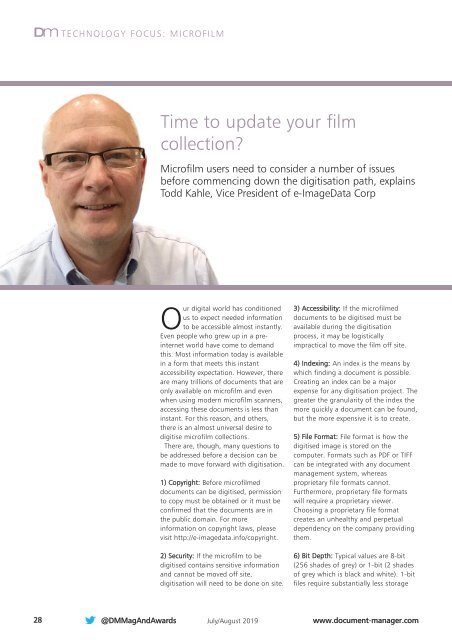DM1907
Create successful ePaper yourself
Turn your PDF publications into a flip-book with our unique Google optimized e-Paper software.
Dm TECHNOLOGY FOCUS: MICROFILM<br />
Time to update your film<br />
collection?<br />
Microfilm users need to consider a number of issues<br />
before commencing down the digitisation path, explains<br />
Todd Kahle, Vice President of e-ImageData Corp<br />
Our digital world has conditioned<br />
us to expect needed information<br />
to be accessible almost instantly.<br />
Even people who grew up in a preinternet<br />
world have come to demand<br />
this. Most information today is available<br />
in a form that meets this instant<br />
accessibility expectation. However, there<br />
are many trillions of documents that are<br />
only available on microfilm and even<br />
when using modern microfilm scanners,<br />
accessing these documents is less than<br />
instant. For this reason, and others,<br />
there is an almost universal desire to<br />
digitise microfilm collections.<br />
There are, though, many questions to<br />
be addressed before a decision can be<br />
made to move forward with digitisation.<br />
1) Copyright: Before microfilmed<br />
documents can be digitised, permission<br />
to copy must be obtained or it must be<br />
confirmed that the documents are in<br />
the public domain. For more<br />
information on copyright laws, please<br />
visit http://e-imagedata.info/copyright.<br />
2) Security: If the microfilm to be<br />
digitised contains sensitive information<br />
and cannot be moved off site,<br />
digitisation will need to be done on site.<br />
3) Accessibility: If the microfilmed<br />
documents to be digitised must be<br />
available during the digitisation<br />
process, it may be logistically<br />
impractical to move the film off site.<br />
4) Indexing: An index is the means by<br />
which finding a document is possible.<br />
Creating an index can be a major<br />
expense for any digitisation project. The<br />
greater the granularity of the index the<br />
more quickly a document can be found,<br />
but the more expensive it is to create.<br />
5) File Format: File format is how the<br />
digitised image is stored on the<br />
computer. Formats such as PDF or TIFF<br />
can be integrated with any document<br />
management system, whereas<br />
proprietary file formats cannot.<br />
Furthermore, proprietary file formats<br />
will require a proprietary viewer.<br />
Choosing a proprietary file format<br />
creates an unhealthy and perpetual<br />
dependency on the company providing<br />
them.<br />
6) Bit Depth: Typical values are 8-bit<br />
(256 shades of grey) or 1-bit (2 shades<br />
of grey which is black and white). 1-bit<br />
files require substantially less storage<br />
28<br />
@DMMagAndAwards<br />
July/August 2019<br />
www.document-manager.com

















